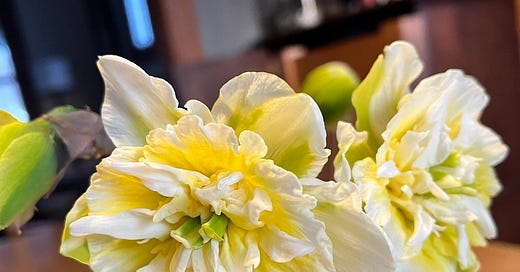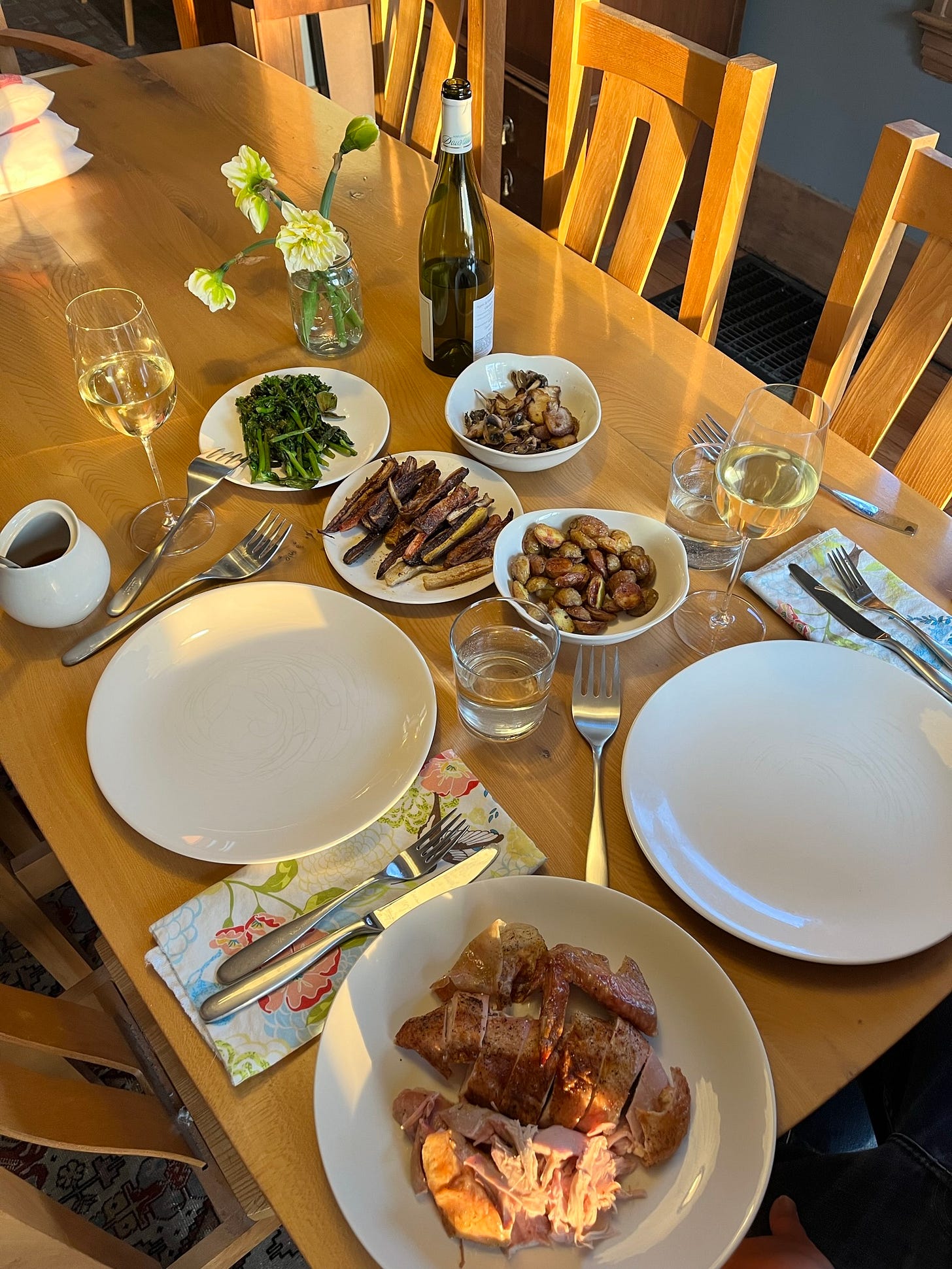The Messy Middle
Some fragmented thoughts on a less-than-celebratory Easter, the beauty of good ingredients, motivation for writing, Maggie Smith's new book, and butterflies
Friday, April 14
Grand Rapids, Mich.
On Sunday, kind reader, Tristan and I walked to church just over a mile from our house. It was Easter. Of course we had to go to church.
Where, O death, is thy sting? Where, O grave, is thy victory?
To some, those words can feel comforting, even triumphant. To others of us, though, they can ring hollow, as they did for me on Sunday. Grief might be fresh enough that death still has its sting. Our losses might cut deeply enough that the grave still seems to have won. Really, all we have to do is to read the headlines on any given day to feel that way.
I don’t know what to do with these truths yet, except to name them.
I don’t know how to inhabit this messy middle—this confounding already and not yet—except to say that it is complicated.
Then I remembered: Easter is not one day; it’s an entire season. These weeks until Pentecost might be harder than Lent for some of us. To live in the light of the resurrection can feel uneasy and uncomfortable, especially when it compels me to confront the difference between healthy sorrow and self-indulgent wallowing. To live in the light of the resurrection might even be better described as a discipline. To live in the light of the resurrection will urge us to use these fifty days well—ten days longer than Lent, ten days more to turn our faces toward hope, ten days more to let our cold hearts be warmed.
I am reminded, too, that resurrection only matters to those who have faced the reality of death. I suppose this is the work that we are called to do, again and again and again. In a world in which death still stings, in a society where the grave still seems so victorious, we struggle toward a different reality, because we believe—because we want to believe—in a different, more hopeful story.
I don’t know how to inhabit this messy middle—this confounding already and not yet—except to keep trying and keep living and keep nurturing whatever I can manage to nurture.
On Sunday afternoon, I closed my laptop and opened my box of seeds, I picked up my trowel and my best-worst farmhand, Fozzie. I headed out to the yard to clean up the garden bed and do some planting: some lettuce, some spinach, some onions (because I always like to plant something that I have entirely failed at growing).
Then I went to the other side of the house, the side that gets the most sunshine. The first daffodils of the season were unfurling in the warmth.
I remember when I planted them. It was a cold and gray day, during that time of year when the nights are still stretching longer and it seems as if nothing is growing. I went back into the house a couple of times to warm my hands, and then I came back out again to hack at the dry soil. Eventually, I had a series of little valleys four and five inches deep, just enough to nestle the bulbs in and let them settle in to do their thing.
Now look at them.
What I’m Cooking: Tristan requested a roast chicken for Easter dinner, so that’s what we had. I roasted potatoes and rainbow carrots in the oven, and I seasoned the carrots with the smoky, spicy merkén that we brought back from Chile. I charred some broccoli rabe on the stovetop, and seasoned it with lemon and red-pepper flakes. And I pan-roasted some mushrooms, with plenty of butter and thyme from the yard. None of it was complicated. No dish had more than three or four ingredients. Even though the meal wasn’t Chinese, it still followed one of the key principles of the Cantonese kitchen: What matters most is having good ingredients.
Your Questions: Last month, I asked if you had any questions for me, and I’ve slowly been working my way through them. Several of you wondered about how to stay motivated about one’s writing. It’s a question I wrestle with often.
I’m going to be the annoying person who answers the question with a question—actually two: For whom are you writing? And why?
Occasionally, I’ll read a post or a tweet from someone who says, “I write because that’s who I am.” If you’re writing for yourself, then a journal is a great place to do it! But if you’re writing to publish—and I’m using the word “publish” very liberally here, meaning anything from a social-media post to a newsletter to a song to a book—then you have to consider the audience.
Let me just speak for myself here: If I am going to be so bold as to publish—by which I mean to make the claim that my words should matter to someone else out there, enough to interject my voice into their day—my purpose cannot and should not be simply to satisfy myself. There has to be a value proposition. There has to be some attempt to offer the reader something new or helpful or illuminating or educational or entertaining. There has to be a “why?” that is compelling enough to keep you writing.
Much of my writing is driven by my desire to be a hopeful presence. When I’m writing for Travel+Leisure, that often means showing readers a side of a destination that they might not glimpse at first glance, an aspect of beauty that might otherwise go unseen. When I’m writing on Instagram or (rarely these days) Twitter, that often means deleting the thing that I actually wrote that was petty and obnoxious, not encouraging or helpful. When I’m writing a sermon, that always means doing my best to intuit what that particular congregation might be experiencing at that moment and how I might be able to meet them there with a bit of good news.
Why do you write?
One other thing that helps motivate me is to read good writing. I enjoy The New Yorker; Lauren Collins, Rebecca Mead, Kelefa Sanneh, and Eliza Griswold are writers whom I particularly admire and read carefully. As I work (ever so slowly) on my next book, I’m also reading mainly in the nature-writing genre; currently, I’m wending my way through Helen McDonald’s exquisitely crafted Vesper Flights. And a recent treasure has been the poet Maggie Smith’s newsletter, “For Dear Life.” Maggie gives other writers a tremendous gift by explaining how she constructs poems. Even though I have not written a poem since the ninth grade and do not plan to curse the world in that way ever again, her thought process inspires and encourages me, and her careful attention to her craft makes me want to be more careful and attentive to mine.
What I’m Reading: Speaking of Maggie Smith, she published a new book this week, called You Could Make This Place Beautiful. It’s a memoir, and even as I type those words, I worry about misleading you.
The book’s title comes from one of her best-known poems, “Good Bones.” Well, the bones of this memoir are very good, but they aren’t conventional memoir-bones. For instance, some chapters are short—one has ten words in its title but just seven in the body. Which made me wonder: Are they really chapters? What even constitutes a chapter?
As I’ve been reading—I’m not done yet, because I just bought it two nights ago—I’ve loved the boldness of her writing. She candidly explores anger and forgiveness, love and loss, in brief bursts of prose (and occasionally, poetry). To me, this is much more how the human memory, or at least my human memory, works—glimpses and mementoes, snatches and snippets. If you were to ask someone to tell you their true story, it would not—it should not—flow out in one fully formed narrative, with tidy beginning, middle, and end. There would—there should—be questions and digressions, wonderings and wanderings. Maggie’s writing feels so true.
If you asked me for my true story, though, I know that my telling would not be as radiant or as elegant as Maggie’s is.
So many of her turns of phrase have stopped me with their originality, with their vividness: She writes about “a vibrating fist of bees.” And about the “discards” of the sea—“on the beach, all those broken pieces left at your feet: shards of abalone, tiger-striped spines of conch, gray wedges of sand dollar, none from the same whole.” And about looking up at the nighttime heavens and seeing “a white smudge of Milky Way I wanted to wipe away. It made a mess of the sky.” (That last observation made me laugh, and I’m not even sure why.)
But then the Maggie Smith I’ve gotten to know a little bit is radiant and elegant, too, so I’m not surprised. She made this book beautiful.
I’m late sending this to you this week because 1) writing has been hard; and 2) my wise husband thought we should take advantage of the glorious springtime weather and spend some time outside. So yesterday morning, we went to Meijer Gardens, one of Grand Rapids’s real gems. Meijer Gardens has a fine collection of sculpture, including works by Henry Moore, Barbara Hepworth, and Mark di Suvero. But what really stirred my wonder and gave me such unexpected delight were the butterflies.
My goodness, these butterflies! Flying masterpieces.
Here’s hoping that you’ll find some wonder in your days, whether on the wings of a butterfly or a morsel of comfort food, an unexpected word of encouragement from a friend or a surprising act of kindness from a stranger. Here’s hoping that you’ll share some wonder with others too.
That’s all I’ve got for this week.
With gratitude,
Jeff








“Much of my writing is driven by my desire to be a hopeful presence.”
What a gift you deliver to us over and over again, even when it’s hard. Thanks, Jeff.
Another wonderful update, Jeff. This week in W Michigan has been glorious. That daffodil variety is beautiful! And good for Tristan suggesting time outdoors, especially at Meijer Gardens.